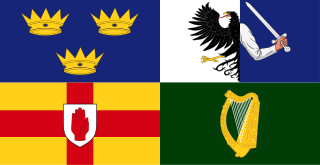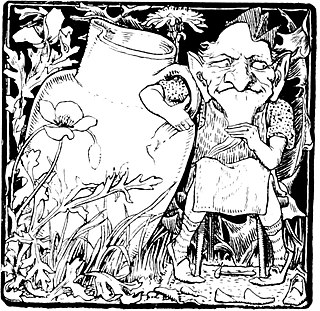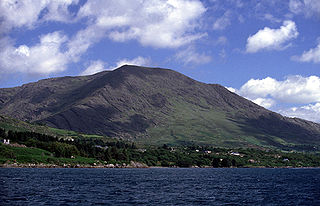
A banshee is a female spirit in Irish folklore who heralds the death of a family member, usually by screaming, wailing, shrieking, or keening. Her name is connected to the mythologically important tumuli or "mounds" that dot the Irish countryside, which are known as síde in Old Irish.

Aos sí is the Irish name for a supernatural race in Celtic mythology – daoine sìth in Scottish Gaelic – comparable to fairies or elves. They are said to descend from the Tuatha Dé Danann, meaning the 'People of Danu', depending on the Abrahamic or pagan tradition.

The púca, pucapwca, pooka, phouka, puck is a creature of Celtic, English, and Channel Islands folklore. Considered to be bringers both of good and bad fortune, they could help or hinder rural and marine communities. Púcaí can have dark or white fur or hair. The creatures were said to be shape-changers that could take the appearance of horses, goats, cats, dogs, and hares. They may also take a human form, which includes various animal features, such as ears or a tail.

A changeling, also historically referred to as an auf or oaf, is a human-like creature found throughout much of European folklore. A changeling was a substitute left by a supernatural being on kidnapping a human being. Sometimes the changeling was a 'stock', more often the changeling was a supernatural being made magically to look like the kidnapped human. Supernatural beings blamed for stealing children included fairies, demons, trolls, nereids and many others. Usually, the kidnapped human was a child; but there were cases, particularly in Scandinavia and Ireland where adults were taken.

Merrow is a mermaid or merman in Irish folklore. The term is anglicised from the Irish word murúch.

The Dullahan, also called Colainn Gan Cheann, is a type of legendary creature in Irish folklore. He is depicted as a headless rider, on a black horse, who carries his own head held high in his hand or under his arm.

Irish folklore refers to the folktales, balladry, music, dance and mythology of Ireland. It is the study and appreciation of how people lived.
Thomas Keightley was an Irish writer known for his works on mythology and folklore, particularly Fairy Mythology (1828), later reprinted as The World Guide to Gnomes, Fairies, Elves, and Other Little People.

Thomas Crofton Croker was an Irish antiquary, best known for his Fairy Legends and Traditions of the South of Ireland (1825–1828), and who also showed considerable interest in Irish song and music.

A gancanagh is a male fairy from the mythology of Northern Ireland, known for seducing women.

The clurichaun or clúrachán is a mischievous fairy in Irish folklore known for his great love of drinking and a tendency to haunt breweries, pubs and wine cellars. He is related to the leprechaun and has sometimes been conflated with him as a shoemaker and a guardian of hidden treasure. This has led some folklorists to suppose that the clurichaun is merely a leprechaun on a drinking spree, while others regard them as regional variations of the same being. Like the leprechaun, the clurichaun is a solitary fairy, encountered alone rather than in groups, as distinct from the trooping fairies.

Hungry Hill or Knockday is the highest of the Caha Mountains on the Beara Peninsula in Munster, Ireland.
The Wonderful Tune is an Irish fairy tale collected in Thomas Crofton Croker's Fairy Tales and Traditions of the South of Ireland (1825–28). Andrew Lang included it in The Lilac Fairy Book, and

Geniscus is a deity who appears in a sermon of Saint Eligius along with Neptune, Orcus, Minerva and Diana. These are all, the Christian homilist says, "demons" who should not be believed in or invoked. The warning implies cult activity for these deities in the northern parts of Merovingian Gaul into the 7th century.

Reverend Charles Bunworth was an Irish harpist and the Church of Ireland rector of Buttevant, County Cork. Born in 1704, he graduated from Trinity College, Dublin with an M.A. in Divinity Studies in 1730 and was ordained the following year. He was a renowned patron of the arts and a skilled harpist. He died in 1772 at the age of 68 and is buried in the churchyard of St John’s, Buttevant.
Marianne Croker (1791–1854) was an English watercolour painter and author of the 19th century.
"The Soul Cages" is a fairy tale invented by Thomas Keightley, originally presented as a genuine Irish folktale in T. Crofton Croker's Fairy Legends and Traditions of the South of Ireland (1825–28). It features a male merrow (merman) inviting a local fisherman to his undersea home. The "soul cages" in the title refer to a collection of human souls that the merman kept in his home.

"The Legend of Knockgrafton" is an Irish folk tale/fairy tale published by T. Crofton Croker in Fairy Legends and Traditions of the South of Ireland (1825).
Michael Leahy was a child who died by drowning in 1826 in Kerry, Ireland. Leahy was four years old at the time of his death. He was believed by some in his community to have been a changeling and the drowning was the result of an attempt to cure him.












